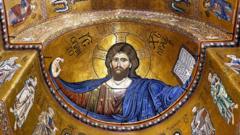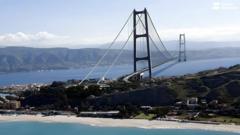Nestled on a hill above Palermo, the Monreale Cathedral in Sicily is a lesser-known yet remarkable example of Italian artistry, famed for its grand Byzantine-style mosaics—the largest in Italy and second globally only to those at Istanbul's Hagia Sophia. Declared a Unesco World Heritage Site in 2015, the cathedral has undergone significant restoration work to return it to its stunning original condition.
Constructed in the 12th century during Norman rule, the cathedral's mosaics were designed to awe, inspire, and humble visitors, drawing influence from the artistic styles of Constantinople. Spanning over 6,400 square meters and containing approximately 2.2 kg of solid gold, these mosaics are visually striking and rich in symbolism, with gold representing the divine in Byzantine art.
The restoration process took over a year and required transforming the cathedral into a construction site, complete with scaffolding surrounding the altar and transept. A team from the Italian Ministry of Culture initiated the work, starting with the removal of decades of dust that had settled on the mosaics. They then repaired damaged tiles and adhered those that were peeling away from the walls.
Father Nicola Gaglio, the cathedral's priest for 17 years, oversaw the restoration closely, referring to the team’s meticulous approach—like "walking on tiptoes" through the work, sometimes halting for solutions to unforeseen challenges. Notably, when approaching the ceiling, they discovered a yellowed layer of varnish that needed peeling away, revealing the true vibrancy underneath.
The restoration also included an upgrade of the cathedral's outdated lighting system. Matteo Cundari, Country Manager of Zumtobel, the firm responsible for the new installation, highlighted the importance of illuminating the mosaics effectively while ensuring the lighting system is replaceable in the future without causing damage.
The initial phase of the restoration cost 1.1 million euros, with plans for a second stage focusing on the central nave. As the scaffolding finally came down, Fr. Gaglio expressed his overwhelming sense of awe at the newly revealed beauty, stating, "It's pure beauty. This world needs beauty, as it reminds us of what's good in humanity."

















